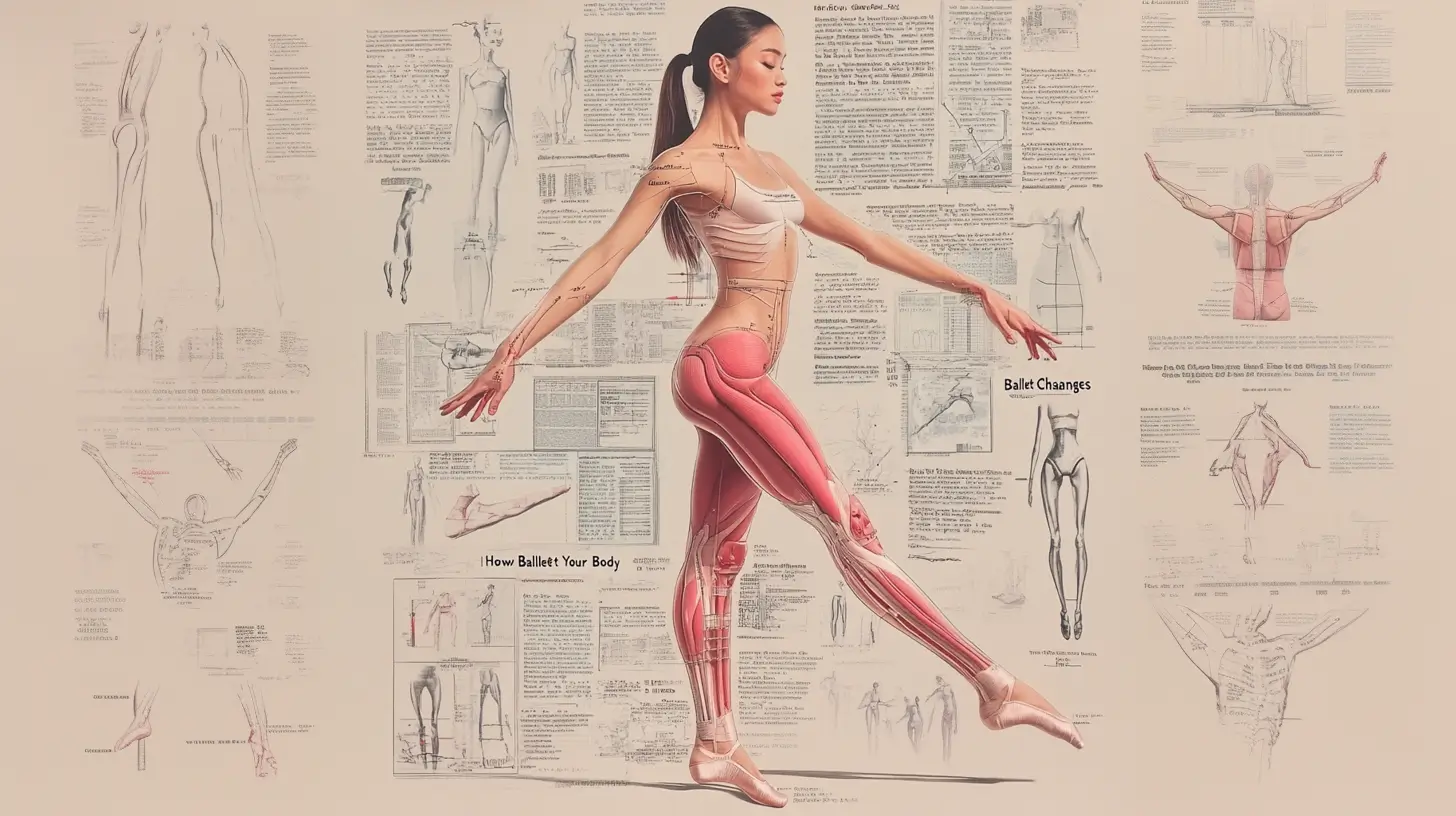Are you curious about how ballet changes your body? Ballet enhances flexibility and posture, builds muscle strength, and boosts mental well-being. Dive into this article to uncover ballet’s specific physical and mental benefits and learn how it can positively impact your life.
Key Takeaways
- Ballet enhances flexibility, posture, and core strength, promoting overall muscle health and reducing the risk of injury.
- Regular ballet practice improves cardiovascular health, increases stamina, and helps maintain bone density, all of which contribute to overall fitness.
- Ballet fosters mindfulness, mental clarity, and cognitive function, serving as a holistic exercise that benefits both body and mind.
Art de Podcast
| Aspect | Benefits | Challenges |
|---|---|---|
| Flexibility | – Improved flexibility in joints and muscles. – Enhanced range of motion, particularly in the hips and legs. | – Risk of over-stretching leading to strains or injuries. – Long-term flexibility maintenance requires consistent practice. |
| Strength | – Develop core strength and stability. – Increases leg and ankle strength, particularly in calves and feet. | – Muscle imbalances can occur if not complemented with cross-training. – High risk of injuries in the Achilles tendon and lower back. |
| Posture | – Promotes proper alignment and posture habits. – Reduces the likelihood of back pain due to stronger core muscles. | – Maintaining correct posture can be strenuous and lead to tension, especially in the neck and shoulders. |
| Coordination | – Enhances overall body coordination and motor skills. – Improves balance and spatial awareness. | – Demanding choreography can lead to mental fatigue. – Complex movements increase the risk of falls or missteps. |
| Endurance | – Boosts cardiovascular endurance with sustained routines. – Enhances muscular endurance, especially in legs and core. | – High-intensity and repetitive movements can cause overuse injuries, such as shin splints. |
| Mental Health | – Reduces stress and anxiety through focused practice. – Encourages mindfulness and emotional expression. | – High pressure to perform perfectly can lead to anxiety and stress. – Risk of developing a negative body image due to aesthetic standards. |
| Flexibility of Mind | – Encourages creativity and artistic expression. – Builds resilience and discipline through challenging practice. | Continuous pursuit of perfection can lead to burnout. – Emotional strain due to rigorous training and performance expectations. |
| Body Composition | – Helps maintain a lean and toned physique. – Promotes overall body awareness and healthy weight management. | – High physical demands can lead to issues like eating disorders. Intense training may cause menstrual irregularities in women. |
Ballet Training Enhances Flexibility and Range of Motion

Flexibility is one of the most celebrated benefits of ballet. Dancers continuously stretch major muscle groups, which helps enhance flexibility and maintain muscle elasticity. Elongation exercises help keep muscles long, and ballet strengthens them, making them more resilient, reducing the risk of injury, and improving overall muscle health.
The flowing movements and constant stretching are why ballet is not just about creating beautiful lines and big movements; they are also about functional fitness. All those flowing movements in ballet strengthen muscles, increasing the range of motion and making everyday activities easier. Imagine bending, twisting, and reaching without any awkward or uncomfortable twists.
Dancers often find that the flexibility gained from ballet helps them release tension and relax their muscles more effectively. This sense of relaxation extends beyond the studio, promoting physical and mental ease in daily life. Ballet exercises act like a gentle massage for the whole body, constantly using muscles to release tension and promote muscle strength.
Improves Posture and Core Strength in Ballet Dancers

Ballet is synonymous with strong posture and a sculpted core. Ballet training significantly enhances core strength by maintaining an upright posture, continuously engaging the core muscles, supporting the spine, and promoting better stability and balance.
Focusing on postural muscles and body alignment in ballet improves posture and enhances body awareness. This heightened awareness, relaxed muscles, and improved coordination contribute to a more stable and balanced physique, which reduces the risk of injury. Ballet exercises resemble body weight exercises, targeting postural muscles and ensuring efficient body support.
The strength gained from ballet training extends beyond the studio. Whether lifting boxes or standing tall, the benefits of a strong core and excellent posture are undeniable. Ballet promotes healthy bones and reduces the likelihood of back pain or other postural issues by strengthening muscles.
Builds Muscle Tone and Strength for a Ballet Body
Ballet builds muscle tone and strength using the weight-bearing form of the dancer’s body weight, creating clear and beautiful lines, unlike traditional weight-bearing exercises. This method ensures muscles strengthen without over-bulking, contributing to a graceful ballet body.
Continuous engagement of the legs, back, core, arms, neck, and feet in ballet promotes muscle health and endurance. Ballet targets multiple and minor muscle groups simultaneously, making it a total-body workout. This holistic approach ensures many muscles are worked, contributing to overall muscle mass and health.
Ballet shapes muscles to enhance physical appearance and functionality. Stronger muscles developed through regular ballet practice improve posture and support healthy bones. Muscle tone and strength can lead to a longer, healthier life, highlighting the importance of many muscles and ballet as a regular exercise regimen.
Ballet Exercises Boost Coordination and Balance

Coordination and balance are fundamental in ballet. Classes require dancers to synchronize arm, leg, and head movements, greatly enhancing overall coordination. This synchronization improves dance precision and everyday coordination skills.
Balancing techniques strengthen the muscles responsible for balance, allowing dancers to hold positions and move with ease and grace. Regular practice fosters control over the body and supports physical stability and spatial awareness, crucial for preventing falls and maintaining a balanced physique.
Ballet improves concentration skills, as ballet classes require dancers to focus intently on movements and timing. Heightened concentration boosts cognitive function and enhances mental acuity. Ballet strengthens muscles to support balance, making it essential for improving coordination and preventing injuries.
Promotes Cardiovascular Health
Ballet is not just about grace and beauty; it’s also an excellent form of cardiovascular exercise. Dynamic movements in ballet increase heart efficiency by improving its ability to pump oxygen-rich blood throughout the body. This cardiovascular training is comparable to high-speed workouts like running or cycling.
Ballet can elevate ‘good’ HDL cholesterol levels while reducing ‘bad’ LDL cholesterol, contributing to a healthier heart. Ballet exercises promote healthy bones and muscles by increasing circulation and strengthening the heart. This dual benefit makes ballet a comprehensive workout for your heart, muscles, and overall health.
Ballet’s efficient calorie-burning helps with weight management and calorie control, while also boosting metabolism. Combining cardiovascular and muscular training in ballet produces more endorphins than other exercises, which enhances both physical and mental well-being. Regular ballet exercise is a powerful way to promote heart health and overall fitness.
Supports Bone Health
Ballet, a weight-bearing exercise, is crucial in maintaining healthy bones. Dynamic movements and isometric contractions in ballet, such as pliés and relevés, apply varying mechanical stress on bones, promoting stronger and denser bone structures. These movements stimulate bone growth and density, which are essential for preventing osteoporosis and other bone-related issues.
Ballet training can also positively influence hormonal balance, particularly estrogen, which is vital for bone health. This hormonal balance further supports healthy bones.
Ballet enhances muscle tone, endurance, and bone strength, making it an ideal activity for maintaining lifelong bone health. Combining muscle and bone benefits highlights ballet’s importance as a holistic workout supporting the body’s structural integrity.
Enhances Mental Well-being

Ballet is a powerful tool for enhancing mental well-being. Physical exercise in ballet triggers endorphins, brain chemicals responsible for happiness and stress relief. These endorphins increase energy and a sense of well-being. Ballet releases more endorphins than aerobic exercises, promoting relaxation and mental clarity.
The discipline and focus required in ballet foster self-discipline, goal-setting skills, and self-confidence. This self-confidence helps dancers overcome initial fears and boosts emotional well-being. Additionally, ballet promotes social interactions and community, which can help reduce anxiety and depression. The New York City Ballet often exemplifies these values in its performances and training.
Combining physical and mental benefits makes ballet a comprehensive approach to enhancing overall mental health.
Increases Stamina and Energy Levels

Ballet provides a total-body workout that integrates various muscle groups, promoting overall fitness and stamina. Dancers can burn between 300 and 500 calories in an hour-long ballet class, which helps increase their energy. A typical ballet class lasts 60 to 90 minutes and involves continuous movement, which helps to elevate heart rates and effectively improve stamina.
Regular ballet practice elevates metabolism and promotes lymph drainage for detoxification, further boosting energy levels. Increased stamina and energy benefit many ballet dancers during performances and help them with daily activities. Combining cardiovascular, muscular, and metabolic benefits, ballet is an excellent choice for improving overall energy levels.
Encourages Mindfulness and Stress Relief
Ballet promotes mindfulness by focusing attention on movements and rhythm, which helps minimize distractions. This focus helps release bodily tension in multiple muscles, promoting relaxation and calmness.
Ballet practice is a creative outlet that reduces stress and anxiety through self-expression. Practicing good breathing techniques and maintaining a straight breathing posture can enhance relaxation and improve mental well-being for many dancers.
Improves Cognitive Function
Practicing ballet is a mental workout that keeps the mind sharp. Learning new routines enhances memory, attention, and problem-solving abilities. The precise movements in ballet training promote improved memory and concentration.
Ballet engages the brain in learning choreography, stimulating neuroplasticity, and enhancing brain connectivity to improve cognitive function. This engagement improves cognitive flexibility and overall mental acuity. The mental benefits of ballet are as significant as the physical ones, making it a holistic exercise for the body and mind.
Ballet Class: A Holistic Workout

A ballet body part class is more than just a dance lesson; it’s a holistic workout that engages the entire body, promoting physical, mental, and emotional well-being. Ballet training involves a series of body-weight exercises that strengthen muscles, promote healthy bones, and help burn calories. By consistently stretching major and minor muscle groups, ballet dancers make their muscles longer, stronger, and more resistant to tearing or strain.
In a typical ballet class, dancers improve their flexibility, balance, and coordination. These classes are designed to enhance cognitive functions such as concentration and memory, making ballet a comprehensive workout for both the body and mind. The following movements and postural exercises in ballet help to relax muscles, improve flexibility, and reduce stress.
The mindfulness practice of good breathing techniques is a key component of ballet training. By focusing on their movements and practicing good breathing techniques, dancers can improve their lung capacity, reduce anxiety, and enhance their overall physical and mental well-being. Ballet classes offer a unique blend of physical exertion and mental relaxation, making them an ideal choice for anyone looking to improve their overall health.
The Risks of Ballet: Foot Injuries and Prevention
While ballet is a holistic workout that offers numerous physical and mental benefits, it carries some risks, particularly for the feet. Ballet dancers are prone to foot injuries, including bunions, hammertoes, and toe deformities, due to the intense pressure and stress on their feet. Poorly fitting footwear, improper training conditions, and intense performances can contribute to the development of these injuries.
Ballet dancers should prioritize foot care and technique to prevent foot injuries. This includes wearing well-fitting shoes that provide adequate support and practicing good foot alignment to avoid awkward or uncomfortable twists and turns. Regular breaks to rest and stretch the feet are essential, as is seeking medical attention if persistent pain, swelling, or bruising occurs.
By taking these precautions, dancers can minimize the risk of foot injuries and continue to enjoy the many benefits of ballet training. Proper foot care and technique are crucial for maintaining the health and longevity of a ballet dancer’s career.
Ballet Training for Adults
Is Adult Ballet a Good Workout? Absolutely! Adult ballet is an excellent workout for individuals of all ages and fitness levels. It is a low-impact exercise that can help improve flexibility, balance, and coordination while strengthening muscles and promoting weight loss. Ballet training for adults can be modified to suit individual needs and abilities, making it an accessible and enjoyable form of exercise for everyone.
Adult ballet classes typically focus on basic ballet techniques, including barre work, center exercises, and floor work. These exercises help improve posture, balance, and coordination, while also enhancing cognitive functions like concentration and memory. By practicing ballet, adults can improve their physical and mental well-being while experiencing the joy and beauty of dance.
Whether you’re a seasoned dancer or a beginner, adult ballet offers a rewarding experience. The combination of physical exertion and mental focus makes it a holistic workout that benefits both the body and mind. So, lace up your ballet shoes and discover the transformative power of ballet training!
Summary
Ballet is a physically demanding activity with numerous physical and mental benefits. From enhancing flexibility and muscle strength to improving cardiovascular and mental well-being, ballet is a comprehensive workout supporting overall health.
Embracing ballet can transform your own body, weight, and mind, fostering a sense of well-being and vitality. Whether you’re a seasoned dancer or a beginner, the journey of ballet promises a rewarding experience.
Frequently Asked Questions
How does ballet improve flexibility?
Ballet improves flexibility through consistent stretching of major muscle groups, which enhances ballet body and overall flexibility and maintains muscle elasticity. This disciplined practice of constantly stretching also allows for a greater range of motion and body awareness.
Can ballet help with posture?
Ballet training significantly enhances core strength and body alignment, improving posture and stability. Engaging in ballet can be an effective method to move back muscles and correct and maintain proper posture.
Is ballet good for cardiovascular health?
Ballet benefits cardiovascular health by enhancing heart efficiency, improving circulation, and positively affecting cholesterol levels. Engaging in ballet can contribute to a healthier heart.
How does ballet support bone health?
Ballet supports bone health as a weight-bearing exercise that enhances bone density and encourages growth through dynamic movements and isometric contractions. Incorporating ballet into your routine can help maintain strong bones.
What are the mental benefits of ballet?
Ballet significantly enhances mental well-being by releasing endorphins, reducing stress and anxiety, fostering self-discipline, and improving cognitive functions such as memory and problem-solving. Engaging in ballet not only nurtures physical grace but also strengthens mental resilience.







